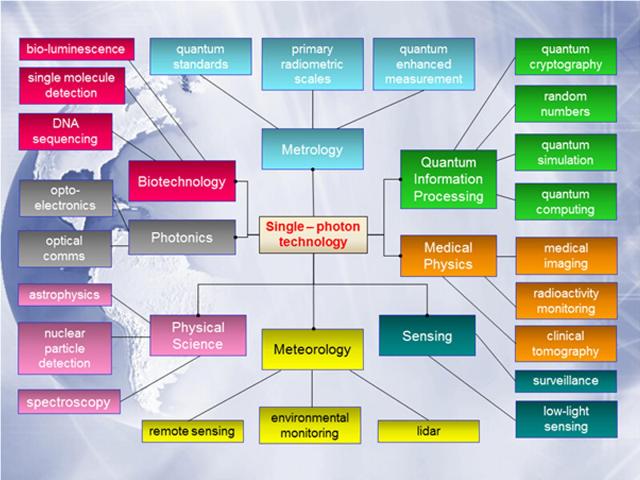Sep 29 2014
A new special section on single-photon detection, generation, and applications in Optical Engineering highlights research on technologies with applications in areas as diverse as space exploration and quantum computing, furthering the field by providing more accurate measurement methods and new analysis techniques. The peer-reviewed journal is published by SPIE, the international society for optics and photonics, in print and in the SPIE Digital Library.
 Single-photon technology has numerous and diverse applications, as illustrated above [Figure 1, "Metrology of single-photon sources and detectors: a review," Christopher Chunnilall, et al. Opt. Eng. 53(8), 081910 (Jul 10, 2014). doi:10.1117/1.OE.53.8.081910]. Credit: Christopher Chunnilall, UK National Physical Lab, et al.
Single-photon technology has numerous and diverse applications, as illustrated above [Figure 1, "Metrology of single-photon sources and detectors: a review," Christopher Chunnilall, et al. Opt. Eng. 53(8), 081910 (Jul 10, 2014). doi:10.1117/1.OE.53.8.081910]. Credit: Christopher Chunnilall, UK National Physical Lab, et al.
The section appears in the August issue, and include nine articles and an editorial outlining the history and future of these technologies.
Each paper describes a new or improved single-photon detection strategy and its applications, including optical time transfer experiments, space missions, superconducting nanowire single-photon detection systems, quantum optics, quantum key distribution, high-volume silicon photomultiplier production, and physical quantum random number generation.
"Beyond the fundamental metrology of single-photon devices, the use of single photons can provide accuracy enhancements in numerous situations involving optical measurements," note special section guest editors Alex McIntosh (MIT Lincoln Lab) and Mark Itzler (Princeton Lightwave Inc.) in their editorial.
Among the benefits of new technologies and methods described in the special section guest are high detection efficiency, low dark-count rate, precise picosecond-scale timing resolution, and fast nanosecond-scale reset times which endow superconducting nanowire single-photon detectors (SNSPD) devices with the highest performance single-photon detection demonstrated to date, the editors write.
Three of the nine articles are open access:
- In "Review of superconducting nanowire single-photon detector system design options and demonstrated performance," Eric Dauler of MIT Lincoln Lab and co-authors compare and describe new and future applications of optical coupling, electrical readout, and SNSPD design with system detection efficiencies of greater than 70 percent. With optical interfaces based on fiber coupling, these detectors are very effective, and further advancements will allow for larger arrays and even higher-performance systems.
- In "Photon counting detector for high-repetition-rate optical time transfer providing extremely high data yield," Josef Blazej of the Czech Technical University and co-authors describe development of a new photon counting detector yielding 50 percent or greater data yields. Operational in the vacuum of space, this detector might be used for optical time transfer experiments on the single-photon signal level or in space exploration missions.
- In "Metrology of single-photon sources and detectors: a review," Christopher Chunnilall of the UK National Physical Lab and co-authors review the numerous advancements and applications of single-photon generation and detection technologies. These technologies will assist in the development of new quantum optical technologies including sensing, computing, and simulation.
Other papers include:
- "Scintillation index measurement using time-correlated single-photon counting laser radar" by Markus Henriksson and Lars Sjöqvist (FOI-Swedish Defence Research Agency)
- "Signal-to-noise ratio of Geiger-mode avalanche photodiode single-photon counting detectors" by Kimberly Kolb (Rochester Institute of Technology)
- "Linear mode photon counting with the noiseless gain HgCdTe e-avalanche photodiode" by Jeffrey Beck (DRS Technologies, Inc.), et al.
- "Update on linear mode photon counting with the HgCdTe linear mode avalanche photodiode" Jeffrey Beck (DRS Technologies, Inc.), et al.
- "Shortwave infrared negative feedback avalanche diodes and solid-state photomultipliers" by Xudong Jiang, et al. (Princeton Lightwave Inc.)
- "High-volume silicon photomultiplier production, performance, and reliability" by Carl Jackson, et al. (SensL).
Articles are available by subscription or pay-per-view in the SPIE Digital Library.
Michael Eismann, Air Force Research Laboratory, is the journal's editor-in-chief.